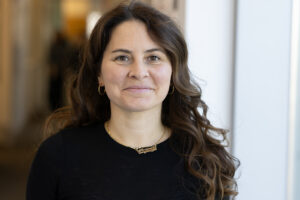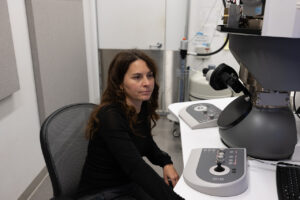Posted on November 15, 2024 in ASRC News, Structural Biology Initiative

Her research will help advance an understanding of how biological molecules function.
Francesca Vallese, Ph.D., joined the ASRC’s Structural Biology Initiative in fall 2024, adding a critical area of research to the initiative’s work to uncover how the particular shape of molecules determines their biological function. Her team studies membrane protein complexes, which have important roles in cellular function. Vallese, also a professor of chemistry and biochemistry at City College, joined the ASRC from Columbia University, where she honed her skills for using single-particle cryo-electron microscopy (cryo-EM) in her research.
Vallese received her bachelor’s and master’s degrees in biotechnology from the University of Padova, Italy and her Ph.D. in biosciences and biotechnologies from the University of Padova. Here, she shares why she chose to join the ASRC and a bit about the goals of her research.
Tell us a bit about the focus of your lab’s research?
Vallese: I’m a structural biologist, so broadly I take proteins and try to solve for their structure, and from there I use this information to identify the function of those proteins. But my questions don’t focus on the function of just a single protein, but rather on how proteins work together to create these dynamic complexes that perform specific functions. My lab sources proteins from human blood, isolating different protein complexes from the membranes of red blood cells for further analysis.

What are the goals of your research?
Vallese: My lab’s overall goal is identifying proteins that are connected to disease across different cell types, so we can work towards treatments. Red blood cells have just a single membrane, making them easy to work with and a good starting point to study membrane protein complexes so we can better understand their role in cellular function and dysfunction. The discoveries we find using red blood cell membranes are often applicable to the surface of other cell types, such as neurons and cardiomyocytes. These findings can then be applied to more complicated cell systems.
What’s your approach to conducting research and training mentees in your new lab?
Vallese: Well, I am still in the process of setting up my lab and hiring new people. I’m coming from a different system in Italy, so there’s a lot of new things I’ve had to learn. We received our first instrument in the lab recently, and I’ve had to avoid looking at it because I’m just so excited to use it. I wake up excited to do my experiments, and even if they don’t always work, I still love the mixture of emotions that come with doing research.
I’m also really looking forward to mentoring my first graduate and undergraduate students in the lab. Thanks to the ASRC, there are a lot of great, diverse undergrads already seeking experience with our research. Being a first-generation college student myself, I’m excited by the idea of training and mentoring other first-generation students and taking on this important responsibility.
What made you choose the ASRC?
Vallese: When I was a postdoc at Columbia University, I was already aware of “the hill” – the physical hill where CCNY, the ASRC, and the NY Structural Biology Center are located, forming a central hub for structural biology research. I always imagined myself being at the center of this community, so when a position opened up, I went for it. At the ASRC, you are always at the center of new innovations. I’m coming here with ideas that I want to evolve with the people I meet, and the collaborations I establish. I came here because it’s a dynamic environment, where people are comfortable dreaming big, thinking outside of the box, and willing to try different approaches. I want my lab to be a place where people come together and are happy to do science, and the ASRC is the perfect setting.
